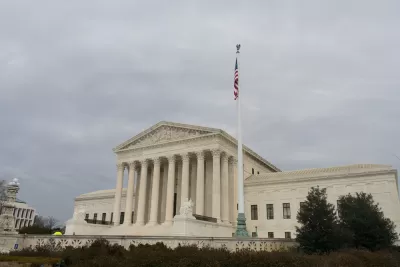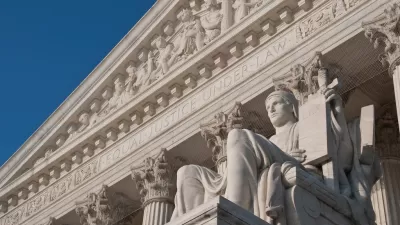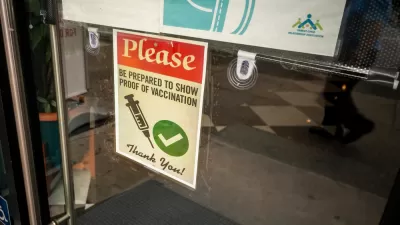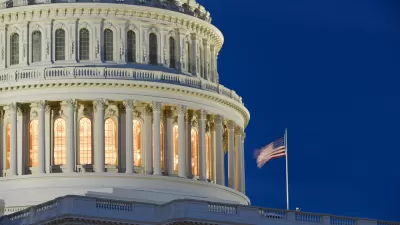The Supreme Court ruled that the Occupational Safety and Health Administration had overreached its authority to protect the health of workers in large private companies. In a separate decision, it upheld a vaccine mandate for most healthcare workers.

In a major blow to the Biden administration's Path Out of the Pandemic plan, the main element being to "vaccinate the unvaccinated," the U.S. Supreme Court on January 13 blocked an emergency temporary standard written by the Occupational Safety and Health Administration (OSHA) that required most workers in large companies (100+ employees) to be vaccinated against COVID-19 or undergo weekly coronavirus testing and wear masks to prevent viral spread.
"The question...is whether the [Occupational Safety and Health] Act plainly authorizes the Secretary [of Labor]’s mandate," referring to the large employer mandate, wrote the majority of justices in the first 10 pages of the 30-page, unsigned opinion in the case, "National Federation of Independent Business v. Department of Labor, Occupational Safety and Health Administration."
"The Act empowers the Secretary to set workplace safety standards, not broad public health measures."
"The vote... was 6 to 3, with the liberal justices in dissent," writes Adam Liptak, who covers the United States Supreme Court for The New York Times. "The ruling means that companies across the country must now decide between protecting employees, potentially losing staff members resistant to complying and running afoul of patchwork regulations."
Complicated but quick path to the Supreme Court
The final decision was noted on page 9 of the 30-page ruling [pdf]:
The applications for stays presented to JUSTICE KAVANAUGH and by him referred to the Court are granted.
The stays refer to the most recent federal appeals court ruling (Sixth Circuit in Cincinnati) that reinstated the OSHA rule on December 17. In November, at least 34 lawsuits against the OSHA rule had been consolidated and sent to the Sixth Circuit in Cincinnati after the Fifth Circuit Court of Appeals in New Orleans had stayed the rule twice.
OSHA had introduced the rule, technically referred to as an emergency temporary standard, on Nov. 4 after President Biden addressed the nation on Sept. 4 to announce his plan to combat the Delta surge. The large employer mandate was but one of four vaccination measures aimed at vaccinating two-thirds of the American workforce. The other three:
- Health care worker mandate, which the justices also decided on Jan. 13 (see below)
- Federal worker vaccine mandate
- Federal contractor and subcontractor vaccine mandate
Healthcare workers mandate
"The vote in the health care case was 5 to 4, with Chief Justice John G. Roberts Jr. and Justice Brett M. Kavanaugh joining the liberal justices to form a majority," adds Liptak. "That second mandate applies to workers at hospitals and other health care facilities that participate in the Medicare and Medicaid programs."
In both the employer and health worker cases, the justices explored whether Congress had authorized the executive branch to take sweeping actions to address the health care crisis.
In the unsigned majority opinion that occupies the first ten pages of the 23-page ruling of "Biden v. Missouri" [pdf], the five justices write, in sharp contrast to their OSHA ruling:
First, we agree with the Government that the Secretary’s rule falls within the authorities that Congress has conferred upon him...
The Secretary of Health and Human Services determined that a COVID–19 vaccine mandate will substantially reduce the likelihood that healthcare workers will contract the virus and transmit it to their patients. He accordingly concluded that a vaccine mandate is “necessary to promote and protect patient health and safety” in the face of the ongoing pandemic.
The rule thus fits neatly within the language of the statute. After all, ensuring that providers take steps to avoid transmitting a dangerous virus to their patients is consistent with the fundamental principle of the medical profession: first, do no harm.
The five justices: Breyer, Sotomayor, Kagan, and the two aforementioned conservative justices, are referring to the governing statute under which the Medicare and Medicaid programs operate. Liptak acknowledged the minority viewpoint:
In dissent, Justice Clarence Thomas, joined by Justices Samuel A. Alito Jr., Neil M. Gorsuch and Amy Coney Barrett, wrote that “scattered provisions” in the statute did not justify the mandate.
Path to Supreme Court
The final decision is noted on the first page of Biden rv. Missouri [pdf]: "Two District Courts enjoined enforcement of the rule, and the Government now asks us to stay those injunctions. Agreeing that it is entitled to such relief, we grant the applications."
Unlike the employer mandate, the Centers for Medicare & Medicaid Services (CMS) mandate never went to an appeals court. Two district courts, one in St. Louis, the other in the Western District of Louisiana, had issued preliminary injunctions on the mandate in November.
Remaining federal vaccine mandates
A three-judge panel of the Sixth U.S. Circuit Court of Appeals in Cincinnati, the same court that ruled in favor of the large employer mandate on Dec. 17, "voted 2-1[pdf] to uphold a ruling by a federal judge in Kentucky which found the Biden administration overstepped its bounds," reported Jared Serbu for the Federal News Network on Jan. 6.
As for federal employees, including those serving in the military forces, the vaccine mandate has so far withstood legal challenges.
Related in Planetizen: Biden administration vaccine mandates
-
Federal Vax-or-Test Mandate for Large Employers Reinstated, December 22, 2021
-
Biden's 'Path Out of the Pandemic' Imperiled by Multiple Court Decisions [federal contractor and subcontractors], December 5, 2021
-
Another Biden COVID Vaccine Mandate on Hold [Healthcare workers], December 1, 2021
- Update: Coronavirus Vaccination Litigation against Biden Administration [consolidation and directed to Sixth Circuit], November 28, 2021
-
Court: Federal COVID-19 'Vaccine or Test-and-Mask' Mandate 'Fatally Flawed,' November 15, 2021
-
Biden Orders Large Employers to Require Vaccination or COVID Testing, September 13, 2021
Supreme Court rulings on other vaccine mandates
-
U.S. Supreme Court Upholds New York State Vaccine Mandate, December 20, 2021
- Supreme Court Allows Indiana University's Vaccine Mandate to Remain in Place, August 16, 2021
Vaccine mandates abroad
- Compulsory Vaccination in the Birthplace of Democracy, December 6, 2021
- Austria to Mandate COVID-19 Vaccination, November 22, 2021
FULL STORY: Supreme Court Blocks Biden’s Virus Mandate for Large Employers

Planetizen Federal Action Tracker
A weekly monitor of how Trump’s orders and actions are impacting planners and planning in America.

Maui's Vacation Rental Debate Turns Ugly
Verbal attacks, misinformation campaigns and fistfights plague a high-stakes debate to convert thousands of vacation rentals into long-term housing.

San Francisco Suspends Traffic Calming Amidst Record Deaths
Citing “a challenging fiscal landscape,” the city will cease the program on the heels of 42 traffic deaths, including 24 pedestrians.

Amtrak Rolls Out New Orleans to Alabama “Mardi Gras” Train
The new service will operate morning and evening departures between Mobile and New Orleans.

The Subversive Car-Free Guide to Trump's Great American Road Trip
Car-free ways to access Chicagoland’s best tourist attractions.

San Antonio and Austin are Fusing Into one Massive Megaregion
The region spanning the two central Texas cities is growing fast, posing challenges for local infrastructure and water supplies.
Urban Design for Planners 1: Software Tools
This six-course series explores essential urban design concepts using open source software and equips planners with the tools they need to participate fully in the urban design process.
Planning for Universal Design
Learn the tools for implementing Universal Design in planning regulations.
Heyer Gruel & Associates PA
JM Goldson LLC
Custer County Colorado
City of Camden Redevelopment Agency
City of Astoria
Transportation Research & Education Center (TREC) at Portland State University
Jefferson Parish Government
Camden Redevelopment Agency
City of Claremont





























